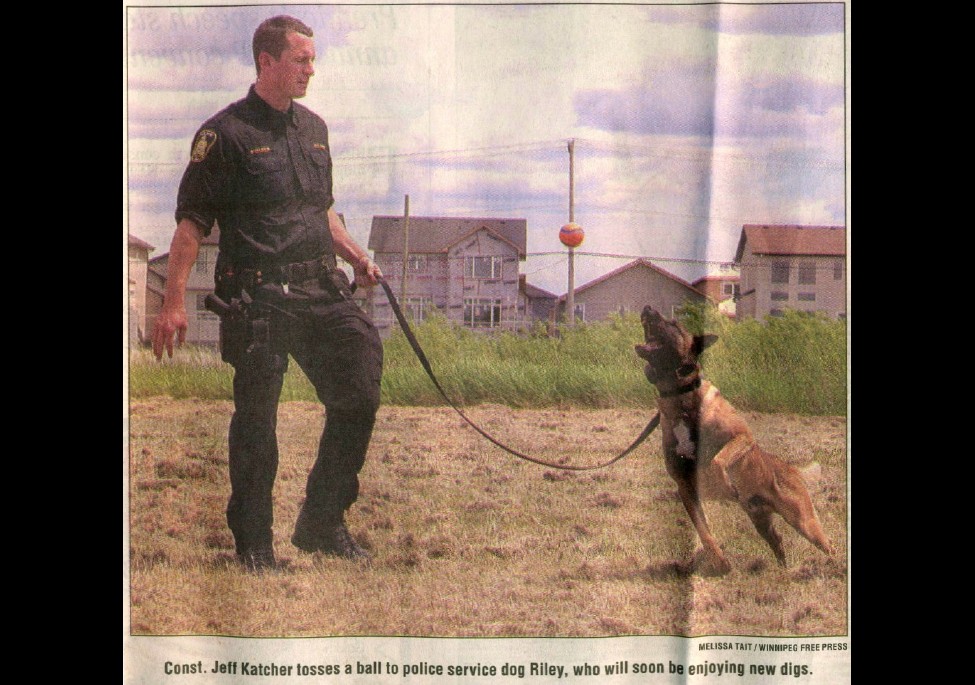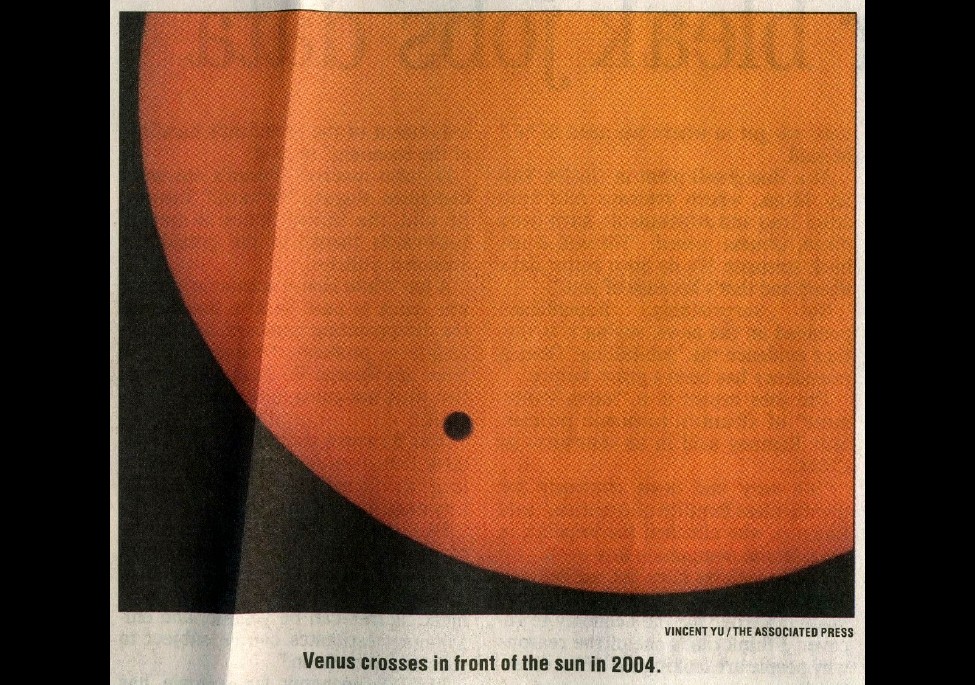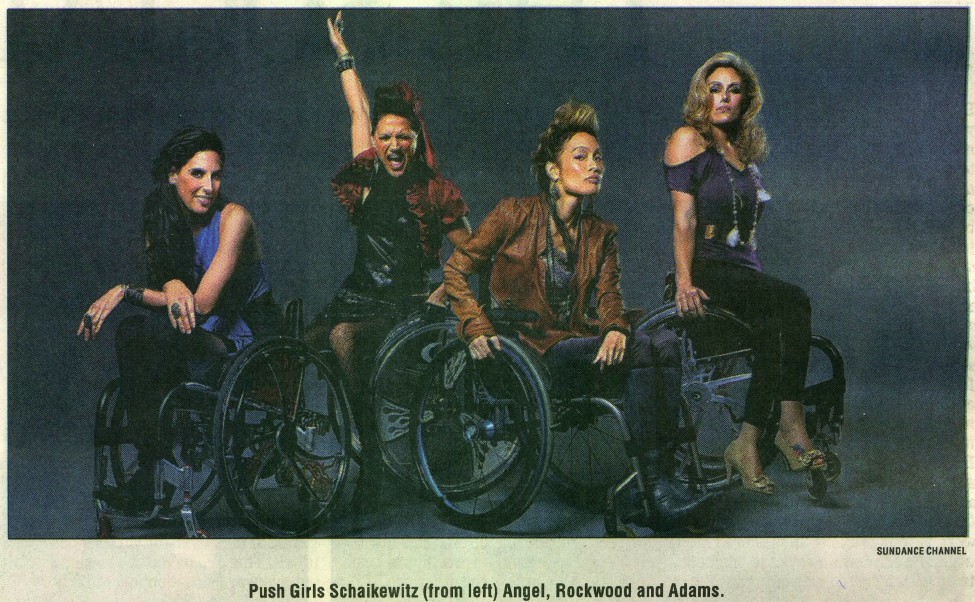
What) The motel we stayed at in Kenora provided us with a free copy of the Saturday June 2, 2012 edition of the Winnipeg Free Press.
Where) In the Jeep
Why) As
there were no Buckys scheduled between here and Selkirk, I spent the time reading the
paper. Every so often a picture would catch Pam's eye
and she would ask me to read her the article. 

You can click here to read the related article or click
the image to see if you like the next one better.
By: Bartley Kives
On: Page A12
The Winnipeg Police Service's canine-unit facility is slated to open by April 2013, almost 2 1/2 years after city council found $1.25 million to build a proper space for working dogs and their handlers. On Friday, Winnipeg police Chief Keith McCaskill and Winnipeg Mayor Sam Katz held a groundbreaking ceremony for a 4,500-square-foot canine-unit centre that will soon rise on a lot south of the East District police station on Dugald Road in Transcona. The new canine-unit facility will have 11 air conditioned indoor kennels with attached dog runs, a grooming area, office space and a classroom for demonstrations. Once complete, it will replace temporary shelters that have been criticized for failing to provide adequate shade for the animals — and subjecting neighbouring apartments to the sound of barking dogs.
City council originally approved the new facility in November 2010, using $1.15 million worth of police funds previously earmarked to purchase radio and dispatch equipment and moving another $100,000 out of a rainy-day fund. An earlier plan to build the unit was dropped due to cost overruns during the construction of the East District police station, which dates back to 2008. The delay in starting construction on the latest plan to build a canine facility stemmed from uncertainty all the desired amenities could be built for $1.25 million, McCaskill told reporters.
"We weren't sure if we had enough money, to be honest with you," he said, adding it took time to come up with the right design. The police service eventually chose Caspian Construction to build the facility, based on a design by Number Ten Architecture Group. "We would have liked to have had it sooner, but you know what? At this stage, we're going to have a facility the members needed, the city needed and the police service needed," McCaskill said.
The Winnipeg Police Service has 12 canine teams, comprised of a total of 12 officers and 23 dogs. Each unit is trained for a particular objective, such as sniffing out explosives, finding illegal drugs or assisting with tactical operations. Since the Winnipeg Police Service is one of the only municipal police forces in Canada to both breed and train its own dogs, the new canine-unit facility will also have a whelping kennel and indoor puppy run. Most of the dogs are Belgian Malinois, a breed that can be trained nine months earlier than a German shepherd and work four years longer, said Sgt. David Bessason, who's in charge of the canine unit. There are also some shepherds and one Labrador retriever in the unit.
The Winnipeg Police Service sells fully trained dogs to other police forces for $50,000 and partly trained puppies for $5,000. But most of the dogs that are trained are kept in Winnipeg, where they form close bonds with their human handlers, Bessason said. Canine-unit police officers will continue to house dogs at their private residences this summer, as the new canine-unit facility will not open until next spring. As recently as October 2011, the police hoped to have the new building open for the summer of 2012. The police hope to raise another $300,000 to build exercise yards and work areas for the dogs alongside the new canine-unit facility, Bessason said. The cash may come from corporate sponsors, conventional city funding or both, he added.
Police canine-unit facility to open in 2013
By: Bartley Kives
On: Page A12
The Winnipeg Police Service's canine-unit facility is slated to open by April 2013, almost 2 1/2 years after city council found $1.25 million to build a proper space for working dogs and their handlers. On Friday, Winnipeg police Chief Keith McCaskill and Winnipeg Mayor Sam Katz held a groundbreaking ceremony for a 4,500-square-foot canine-unit centre that will soon rise on a lot south of the East District police station on Dugald Road in Transcona. The new canine-unit facility will have 11 air conditioned indoor kennels with attached dog runs, a grooming area, office space and a classroom for demonstrations. Once complete, it will replace temporary shelters that have been criticized for failing to provide adequate shade for the animals — and subjecting neighbouring apartments to the sound of barking dogs.
City council originally approved the new facility in November 2010, using $1.15 million worth of police funds previously earmarked to purchase radio and dispatch equipment and moving another $100,000 out of a rainy-day fund. An earlier plan to build the unit was dropped due to cost overruns during the construction of the East District police station, which dates back to 2008. The delay in starting construction on the latest plan to build a canine facility stemmed from uncertainty all the desired amenities could be built for $1.25 million, McCaskill told reporters.
"We weren't sure if we had enough money, to be honest with you," he said, adding it took time to come up with the right design. The police service eventually chose Caspian Construction to build the facility, based on a design by Number Ten Architecture Group. "We would have liked to have had it sooner, but you know what? At this stage, we're going to have a facility the members needed, the city needed and the police service needed," McCaskill said.
The Winnipeg Police Service has 12 canine teams, comprised of a total of 12 officers and 23 dogs. Each unit is trained for a particular objective, such as sniffing out explosives, finding illegal drugs or assisting with tactical operations. Since the Winnipeg Police Service is one of the only municipal police forces in Canada to both breed and train its own dogs, the new canine-unit facility will also have a whelping kennel and indoor puppy run. Most of the dogs are Belgian Malinois, a breed that can be trained nine months earlier than a German shepherd and work four years longer, said Sgt. David Bessason, who's in charge of the canine unit. There are also some shepherds and one Labrador retriever in the unit.
The Winnipeg Police Service sells fully trained dogs to other police forces for $50,000 and partly trained puppies for $5,000. But most of the dogs that are trained are kept in Winnipeg, where they form close bonds with their human handlers, Bessason said. Canine-unit police officers will continue to house dogs at their private residences this summer, as the new canine-unit facility will not open until next spring. As recently as October 2011, the police hoped to have the new building open for the summer of 2012. The police hope to raise another $300,000 to build exercise yards and work areas for the dogs alongside the new canine-unit facility, Bessason said. The cash may come from corporate sponsors, conventional city funding or both, he added.


You can click here to read the related article or
click the image to see if you like the next one better.
Miss
this show and you'll wait 105 years
Transit of Venus to occur Tuesday
Transit of Venus to occur Tuesday
By: Alicia Chang
On: Page A26
LOS ANGELES — It's a spectacle that won't repeat for another century — the sight of Venus slowly inching across the face of the sun. So unless scientists discover the fountain of youth, none of us alive today will likely ever witness this celestial phenomenon again, dubbed a "transit of Venus." It's so unique museums and schools around the globe are hosting Venus-viewing festivities — all for a chance to see our star sport a fleeting beauty mark. Even astronauts aboard the International Space Station plan to observe the event.
The drama unfolds Tuesday afternoon from the Western Hemisphere (Wednesday morning from the Eastern Hemisphere.) Venus will appear as a small black dot gliding across the disk of the sun. As in a solar eclipse, do not stare directly at the sun; wear special protective glasses. The entire transit, lasting six hours and 40 minutes, will be visible from the western Pacific, eastern Asia and eastern Australia. Skywatchers in the United States, Canada, Mexico, Central America and the northern part of South America will see the beginning of the show before the sun sets. Europe, western and central Asia, eastern Africa and western Australia will catch the tail end after sunrise. Those who don't want to leave their homes can follow live webcasts by NASA and various observatories.
"Anything silhouetted on the sun looks interesting. Seeing Venus is extremely rare," said astronomer Anthony Cook of the Griffith Observatory. Perched on the south slope of Mount Hollywood in Los Angeles, the observatory is girding for heavy traffic Tuesday afternoon as throngs are expected to peer through telescopes with special filters set up on the lawn. Skygazers who want the full experience are flocking to Hawaii, considered one of the prime viewing spots since the whole transit will be visible. From the world-famous Waikiki Beach on Oahu to the summit of Mauna Kea on the Big Island, eclipse glasses will be passed out so people can sa|ely see Venus crossing without damaging their eyes.
Just remember to have patience. "There's no one big climactic moment. It takes longer to happen" than a solar or lunar eclipse, said Larry O'Hanlon, who does outreach at the W.M. Keck Observatory on the Big Island. The second planet from the sun between Mercury and Earth, Venus is about the same size as Earth. It appears as one of the brightest objects in the night sky because its thick clouds reflect much of the sunlight back into space. There will be no obvious change to the brightness of the sky during the event; Venus only blocks out a tiny fraction of the sun. "You have to know it's happening," said David DeVorkin, a senior curator at the Smithsonian's National Air and Space Museum.
Venus is the third celestial show to grace the sky in less than a month. Just a day earlier, a partial lunar eclipse will be visible from western North America, South America, Australia and eastern Asia. And there was the much-hyped "ring of fire" solar eclipse on May 20. Unlike eclipses, Venus transits are truly rare. They come in pairs, separated by more than 100 years. The last one occurred in 2004 and the next pair in 2117 and 2125.
Since the German astronomer Johannes Kepler first predicted it in the 17th century, only six have been observed. The upcoming one will be the seventh. Only two people were said to have seen the transit of 1639. The 1882 transit was a bigger deal — people jammed the sidewalks of New York City and paid 10 cents to peek through a telescope. John Philip Sousa even composed a score called Transit of Venus March. The one in 2004 was viewed by millions — in person and online.
The early Venus viewings were a big deal to scientists who used the alignment to measure the size of our solar system. The technique is still used today to search for alien worlds outside our solar system.


Pam did not ask me to read this article but I had an interest in reading it because of another Buckys.
These
girls push the limits
By: Sandy Cohen
On: Page G7
LOS ANGELES — In the opening moments of a new reality show, a pretty blond pulls up to a gas station in her sporty Mustang. As she fills the tank, she catches the eye of a man across the station and smiles. Soon she drives away, waving to her admirer as she leaves.
Another Kardashian-style series? Not quite. Around her fueling and flirting, we also see the woman assembling a wheelchair, popping herself into it and then disassembling the chair before driving off. The blond is 28-year-old Tiphany Adams, one of the stars of Push Girls, a Sundance Channel reality series premiering Monday, June 4, that takes viewers into the lives of four beautiful wheelchair-bound women. All paralyzed through injury or illness, Adams and her three best friends — Mia Schaikewitz, 33, Auti Angel, 42, and Angela Rockwood, 36 — are shown navigating everyday challenges of all sizes, from putting on njakeup to starting a family. It's an unprecedented look at the lives of disabled women, catheters and all, and either a new high or new low for reality TV.
"As a community, we say we want to be treated like everyone else. Well, everyone else has a reality show," said Paul Tobin, president and chief executive of United Spinal Association, an advocacy organization for people with spinal cord injuries. "These aren't the Mob Wives.... My belief is that Push Girls will help dispel preconceived notions by showing people living their lives and enjoying the same things as everyone else, just a little bit differently." The Christopher & Dana Reeve Foundation, another spinal cord injury advocacy group, is promoting Push Girls and joining with Sundance Channel to raise funds for research. Reeve Foundation president and chief executive Peter Wilderotter called the show "a media milestone."
"It truly is reality and it's bringing home what it's like to live with a spinal cord injury," he said. "With these women's sense of style, sense of humour, and sense of who they are and what they're going through, the portrait is really important because I think most people don't really think about what life is like in a chair."
Push Girls star Angel never did. A professional hip-hop dancer who toured with artists such as N.W.A. and LL Cool J, Angel's spinal cord was snapped in a 1992 car accident. She was paralyzed from the waist down and has used a wheelchair ever since. "Before my car accident, when I was an able-bodied person, I never met a person with a disability," she said. "So I would be in the same boat with the viewers, like wow, they can have kids? And they don't marry other people in wheelchairs?" Angel allows the cameras to eavesdrop on her private conversations with her husband about having a baby, one of the show's ongoing story lines.
Producer Gay Rosenthal said she was inspired to make Push Girls after meeting Rockwood, a model and actress who became a quadriplegic after a 2001 car accident. "I was really taken with her," the producer said. Then she met Rockwood's best friends and "it changed my life. This is why I do what I do," she said. "They're more able bodied than some able-bodied people. They're so inspirational."
Schaikewitz said her paralysis at age 15 from a ruptured vessel in her spinal cord is "the best thing that ever happened to me, for reasons that I am able to open somebody's mind by doing an everyday normal activity. "I don't even have to converse with somebody," she said. "They see me pumping gas and that changes their day. To me, that is a huge gift."
For Tiphany Adams, the woman at the gas station, the series tells the world she still has what it takes. "It's about awareness. It's about showing you that we are courageous and we still have power and that enthusiasm for life," she said. "We still love shopping. We still love flirting our wheels off."


